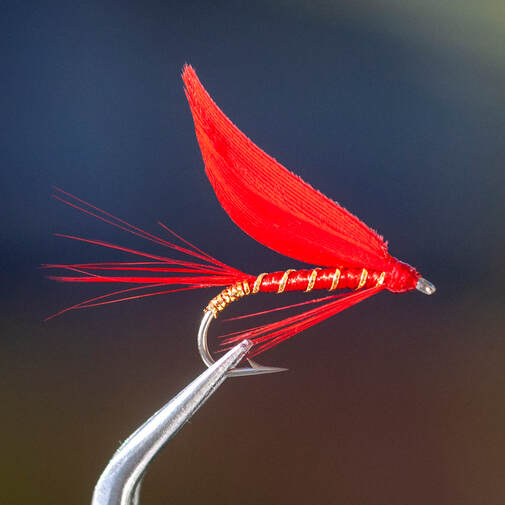Iris Streamer
During the cold winter days after the Thanksgiving and Christmas holidays, fly-fishing with a streamer is an excellent means of attracting and catching a trout. Surface feeding is limited to a warmer day with tiny midges or an overcast day with small blue winged olives. Most of the catching opportunity is underwater. The choices for the angler are wet flies, soft hackle flies, nymphs, streamers or attractor patterns such as an egg, egg cluster, San Juan worm, Y2K, Estes’ Mop Fly or a Squiggly-Wiggly.
Choose a streamer because larger trout primarily eat small forage fish, crayfish and hellgrammites year-round and especially during the winter when food is much harder to find. Top of the list is an olive woolly bugger or a black ghost. On our list to try next is an experimental streamer from 1939.
Iris Streamer Series
Iris No. 1 is a streamer fly, designed and patented by Preston J. Jennings. Patent No. 2,188,753 was filed July 8, 1939 and allowed January 30, 1940. From the Patent: “The proper coloring of the lure is determined by viewing the object which it is desired to simulate through a prism and coloring the lure in exactly the same manner as it appears through the prism.”
Jennings claimed as a theory that: “Light entering the water from an acute angle is bent or refracted at the surface. This bending causes sunlight to split into the basic colored lights which form sunlight. That the design is the impression of how a small fish would appear to a gamefish when viewed in this refracted light. The basic colors being red, blue, green, yellow, the predominate colors of the spectrum are arranged in the same order as when viewed through a prism, illuminated by reflected light or silhouetted against a source of light.”
Preston J. Jennings the inventor is the author of A Book of Trout Flies, an instructive volume published in 1935. Jennings developed an entire series of Ibis streamers including: Murky Iris, Lord Iris, Iris No. 4, Iris No. 3, Iris No. 2, Lady Iris and one streamer that has no name. He also created the Light Silhouette Minnow and the Dark Silhouette Minnow. All these fly patterns had the qualities of a multi-colored, prismatic streamer.
Jennings was an individual who viewed the world of fly-fishing differently. After thousands of wet fly and streamer fly patterns had been created by some of the best anglers on earth, Jennings came along and added yet another unique chapter to the fly pattern recipe book for streamers.
Fish the Iris No. 1 streamer in the same manner as any other streamer. The experimental part is to use the streamer in the full sunlight of early morning and late evening when the prismatic effects are theoretically in place. If you research Preston J. Jennings, you will find that he was a very successful angler and other anglers followed his advice in his time and he still has followers today.
Iris No. 1
Fly of the Month 01.19
Tom Adams and Alen Baker
References:
Smedley, Harold Hinsdill. Fly Patterns and Their Origins, 1944
www.globalflyfisher.com
Choose a streamer because larger trout primarily eat small forage fish, crayfish and hellgrammites year-round and especially during the winter when food is much harder to find. Top of the list is an olive woolly bugger or a black ghost. On our list to try next is an experimental streamer from 1939.
Iris Streamer Series
Iris No. 1 is a streamer fly, designed and patented by Preston J. Jennings. Patent No. 2,188,753 was filed July 8, 1939 and allowed January 30, 1940. From the Patent: “The proper coloring of the lure is determined by viewing the object which it is desired to simulate through a prism and coloring the lure in exactly the same manner as it appears through the prism.”
Jennings claimed as a theory that: “Light entering the water from an acute angle is bent or refracted at the surface. This bending causes sunlight to split into the basic colored lights which form sunlight. That the design is the impression of how a small fish would appear to a gamefish when viewed in this refracted light. The basic colors being red, blue, green, yellow, the predominate colors of the spectrum are arranged in the same order as when viewed through a prism, illuminated by reflected light or silhouetted against a source of light.”
Preston J. Jennings the inventor is the author of A Book of Trout Flies, an instructive volume published in 1935. Jennings developed an entire series of Ibis streamers including: Murky Iris, Lord Iris, Iris No. 4, Iris No. 3, Iris No. 2, Lady Iris and one streamer that has no name. He also created the Light Silhouette Minnow and the Dark Silhouette Minnow. All these fly patterns had the qualities of a multi-colored, prismatic streamer.
Jennings was an individual who viewed the world of fly-fishing differently. After thousands of wet fly and streamer fly patterns had been created by some of the best anglers on earth, Jennings came along and added yet another unique chapter to the fly pattern recipe book for streamers.
Fish the Iris No. 1 streamer in the same manner as any other streamer. The experimental part is to use the streamer in the full sunlight of early morning and late evening when the prismatic effects are theoretically in place. If you research Preston J. Jennings, you will find that he was a very successful angler and other anglers followed his advice in his time and he still has followers today.
Iris No. 1
Fly of the Month 01.19
Tom Adams and Alen Baker
References:
Smedley, Harold Hinsdill. Fly Patterns and Their Origins, 1944
www.globalflyfisher.com

